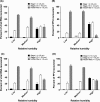Evaluation of bioaerosol samplers for the detection and quantification of influenza virus from artificial aerosols and influenza virus-infected ferrets
- PMID: 31541519
- PMCID: PMC6800310
- DOI: 10.1111/irv.12678
Evaluation of bioaerosol samplers for the detection and quantification of influenza virus from artificial aerosols and influenza virus-infected ferrets
Abstract
Background: Bioaerosol sampling devices are necessary for the characterization of infectious bioaerosols emitted by naturally-infected hosts with acute respiratory virus infections. Assessment of these devices under multiple experimental conditions will provide insight for device use.
Objectives: The primary objective of this study was to assess and compare bioaerosol sampling devices using a) an in vitro, environmentally-controlled artificial bioaerosol system at a range of different RH conditions and b) an in vivo bioaerosol system of influenza virus-infected ferrets under controlled environmental conditions. Secondarily, we also sought to examine the impact of NSAIDs on bioaerosol emission in influenza virus-infected ferrets to address its potential as a determinant of bioaerosol emission.
Methods: We examined the performance of low and moderate volume bioaerosol samplers for the collection of viral RNA and infectious influenza virus in vitroand in vivo using artificial bioaerosols and the ferret model of influenza virus infection. The following samplers were tested: the polytetrafluoroethylene filter (PTFE filter), the 2-stage National Institute of Occupational Safety and Health cyclone sampler (NIOSH cyclone sampler) and the 6-stage viable Andersen impactor (Andersen impactor).
Results: The PTFE filter and NIOSH cyclone sampler collected similar amounts of viral RNA and infectious virus from artificially-generated aerosols under a range of relative humidities (RH). Using the ferret model, the PTFE filter, NIOSH cyclone sampler and the Andersen impactor collected up to 3.66 log10 copies of RNA/L air, 3.84 log10 copies of RNA/L air and 6.09 log10 copies of RNA/L air respectively at peak recovery. Infectious virus was recovered from the PTFE filter and NIOSH cyclone samplers on the peak day of viral RNA recovery.
Conclusion: The PTFE filter and NIOSH cyclone sampler are useful for influenza virus RNA and infectious virus collection and may be considered for clinical and environmental settings.
Keywords: bioaerosol samplers; bioaerosols; ferret model; influenza virus.
© 2019 The Authors. Influenza and Other Respiratory Viruses Published by John Wiley & Sons Ltd.
Figures





Similar articles
-
Bioaerosol and surface sampling for the surveillance of influenza A virus in swine.Transbound Emerg Dis. 2019 May;66(3):1210-1217. doi: 10.1111/tbed.13139. Epub 2019 Mar 9. Transbound Emerg Dis. 2019. PMID: 30715792
-
Detection of Airborne Influenza A and SARS-CoV-2 Virus Shedding following Ocular Inoculation of Ferrets.J Virol. 2022 Dec 21;96(24):e0140322. doi: 10.1128/jvi.01403-22. Epub 2022 Nov 30. J Virol. 2022. PMID: 36448801 Free PMC article.
-
Comparison of samplers collecting airborne influenza viruses: 1. Primarily impingers and cyclones.PLoS One. 2021 Jan 28;16(1):e0244977. doi: 10.1371/journal.pone.0244977. eCollection 2021. PLoS One. 2021. PMID: 33507951 Free PMC article.
-
A Guide for the Use of the Ferret Model for Influenza Virus Infection.Am J Pathol. 2020 Jan;190(1):11-24. doi: 10.1016/j.ajpath.2019.09.017. Epub 2019 Oct 23. Am J Pathol. 2020. PMID: 31654637 Free PMC article. Review.
-
Advances in understanding bioaerosol release characteristics and potential hazards during aerobic composting.Sci Total Environ. 2024 May 20;926:171796. doi: 10.1016/j.scitotenv.2024.171796. Epub 2024 Mar 20. Sci Total Environ. 2024. PMID: 38513848 Review.
Cited by
-
Comparative Assessment of Severe Acute Respiratory Syndrome Coronavirus 2 Variants in the Ferret Model.mBio. 2022 Oct 26;13(5):e0242122. doi: 10.1128/mbio.02421-22. Epub 2022 Sep 22. mBio. 2022. PMID: 36135377 Free PMC article.
-
Research advances in microfluidic collection and detection of virus, bacterial, and fungal bioaerosols.Mikrochim Acta. 2024 Feb 14;191(3):132. doi: 10.1007/s00604-024-06213-7. Mikrochim Acta. 2024. PMID: 38351367 Review.
-
Comparison of three air samplers for the collection of four nebulized respiratory viruses - Collection of respiratory viruses from air.Indoor Air. 2021 Nov;31(6):1874-1885. doi: 10.1111/ina.12875. Epub 2021 Jun 14. Indoor Air. 2021. PMID: 34124803 Free PMC article.
-
Inherent Heterogeneity of Influenza A Virus Stability following Aerosolization.Appl Environ Microbiol. 2022 Feb 22;88(4):e0227121. doi: 10.1128/aem.02271-21. Epub 2022 Jan 5. Appl Environ Microbiol. 2022. PMID: 34985975 Free PMC article.
-
Definition of an Indoor Air Sampling Strategy for SARS-CoV-2 Detection and Risk Management: Case Study in Kindergartens.Int J Environ Res Public Health. 2022 Jun 16;19(12):7406. doi: 10.3390/ijerph19127406. Int J Environ Res Public Health. 2022. PMID: 35742654 Free PMC article.
References
-
- Bridges CB, Kuehnert MJ, Hall CB. Transmission of influenza: implications for control in health care settings. Clin Infect Dis. 2003;37(8):1094‐1101. - PubMed
Publication types
MeSH terms
Substances
Grants and funding
LinkOut - more resources
Full Text Sources

